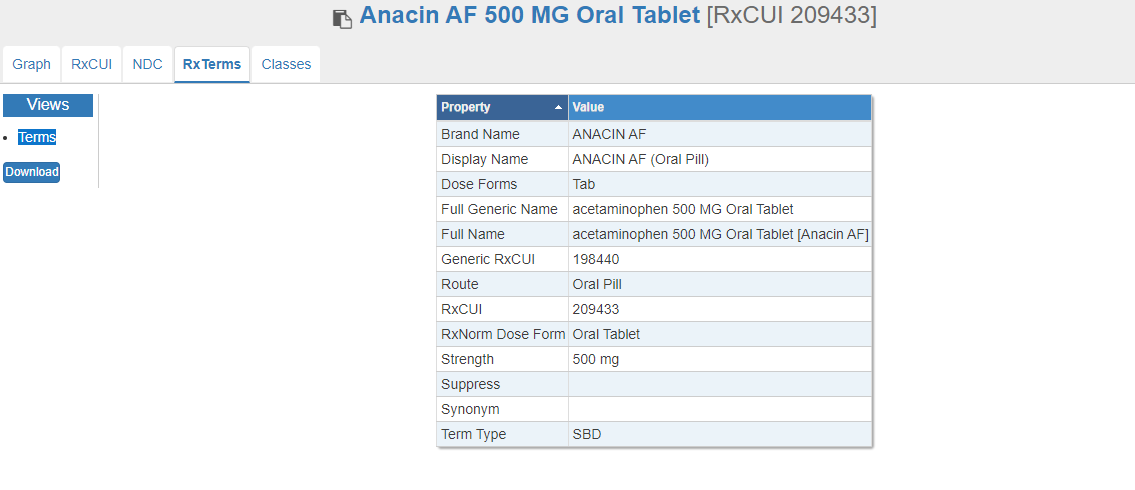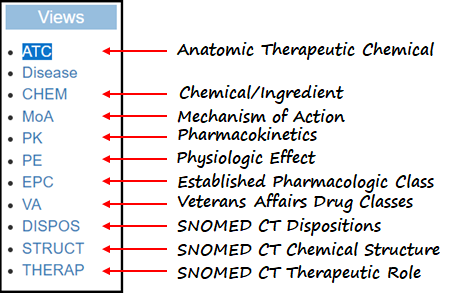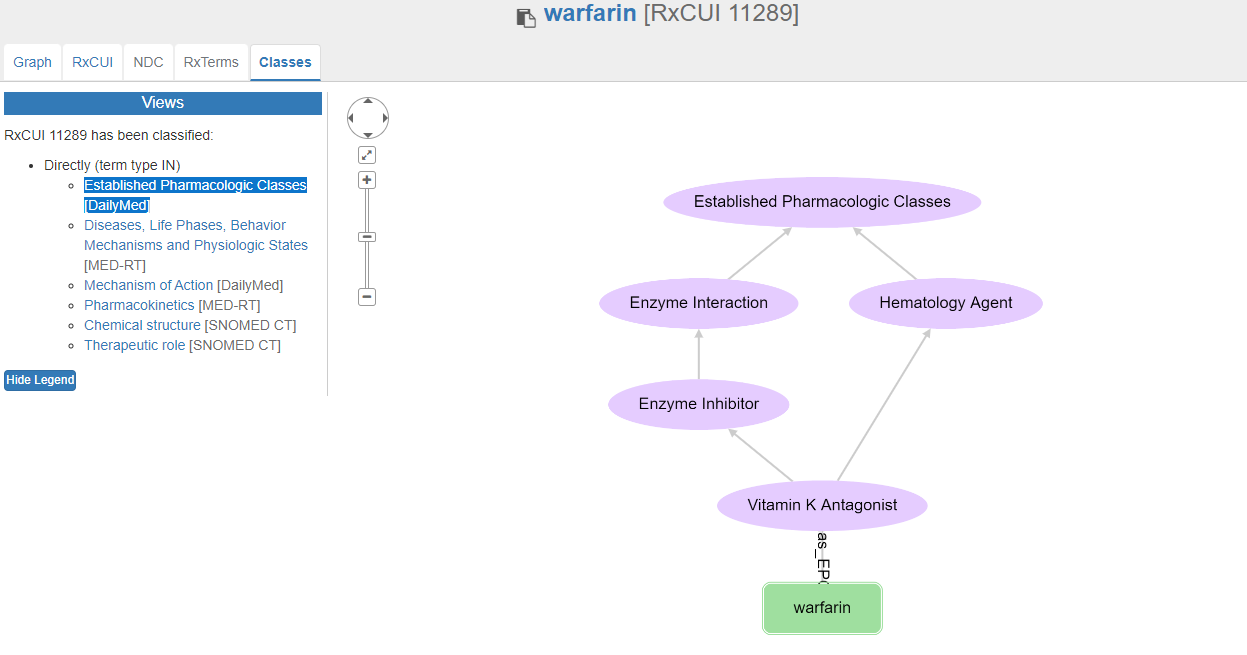APPLICATIONS

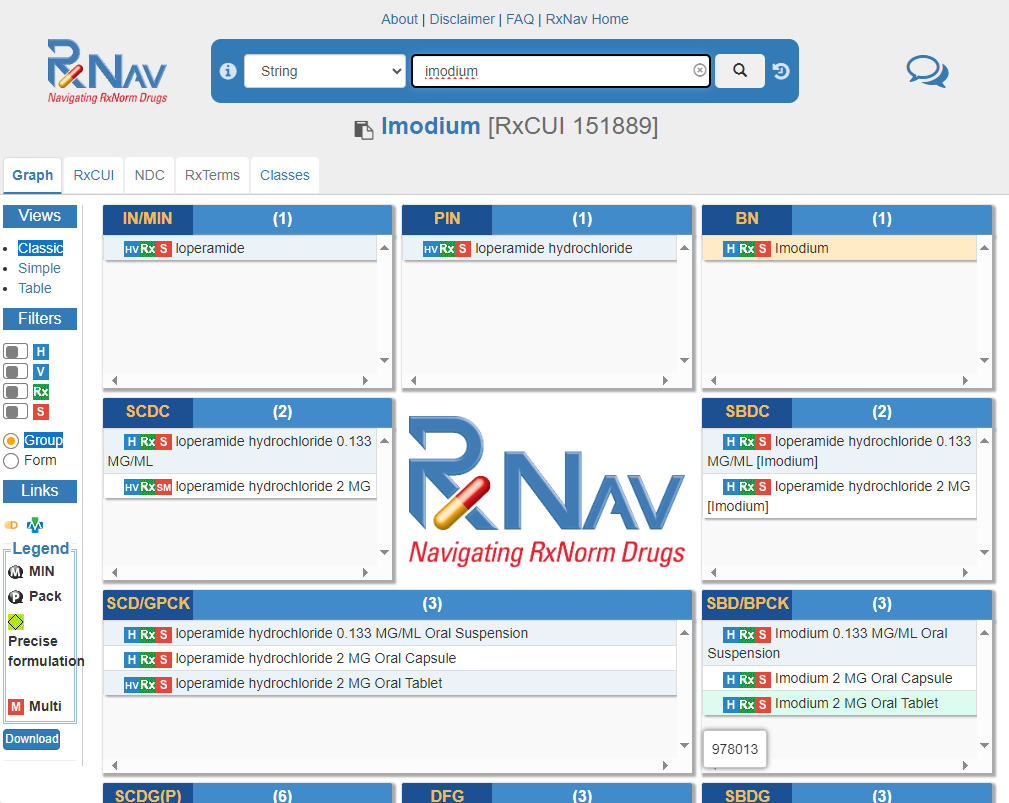
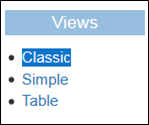
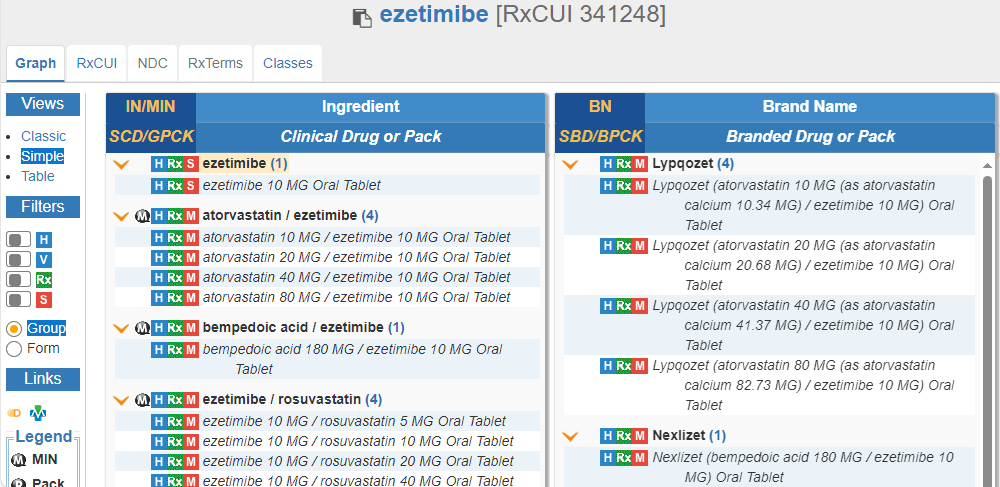
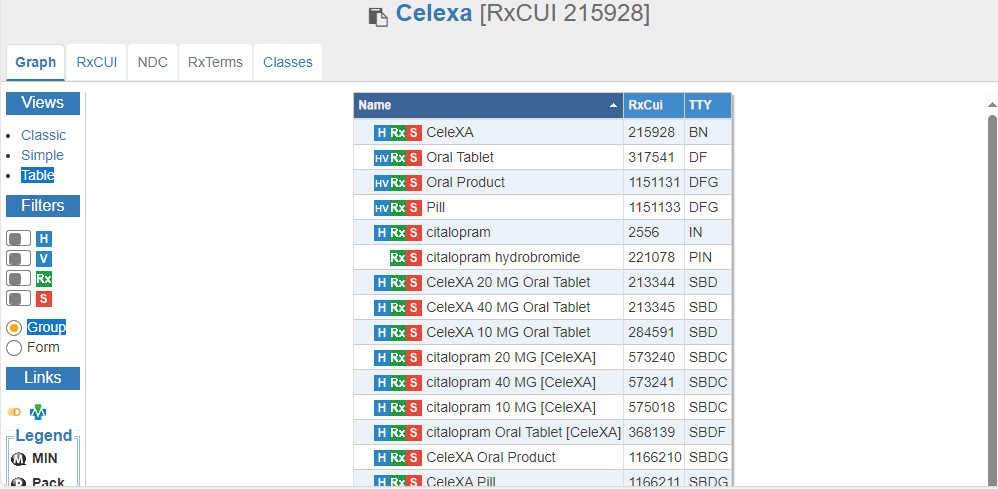



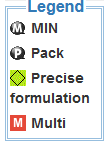

| BN - brand name | SBD - branded drug |
| BPCK - branded pack | SBDC - branded drug component |
| DF - dose form | SBDF - branded dose form |
| DFG - dose form group | SBDG - branded dose form group |
| GPCK - generic pack | SCD - clinical drug |
| IN - ingredient | SCDC - clinical drug component |
| MIN - multiple ingredients | SCDF - clinical dose form |
| PIN - precise ingredient | SCDG - clinical dose form group |
| Start to End | Path | Start to End | Path |
|---|---|---|---|
| BN => BPCK |
BN => SBD => BPCK
|
SBDF => SBDC |
SBDF => SBD => SBDC
|
| BN => DF |
BN => SBD => SCD => DF
|
SBDF => SBDFP |
SBDF => SBDFP
|
| BN => DFG |
BN => SBD => SBDG => DFG
|
SBDF => SBDG |
SBDF => SBDG
|
| BN => GPCK |
BN => SBD => SCD => GPCK
|
SBDF => SCD |
SBDF => SBD => SCD
|
| BN => IN |
BN => IN
|
SBDF => SCDC |
SBDF => SBD => SCD => SCDC
|
| BN => MIN |
BN => SBD => SCD => MIN
|
SBDF => SCDF |
SBDF => SCDF
|
| BN => PIN[1] |
BN => PIN
|
SBDF => SCDFP |
SBDF => SCDF => SCDFP
|
| BN => SBD |
BN => SBD
|
SBDF => SCDG |
SBDF => SBDG => SCDG
|
| BN => SBDC |
BN => SBDC
|
SBDF => SCDGP |
SBDF => SBDG => SCDGP
|
| BN => SBDF |
BN => SBDF
|
SBDFP => BN |
SBDFP => SBDF => BN
|
| BN => SBDFP |
BN => SBDF => SBDFP
|
SBDFP => BPCK |
SBDFP => SBD => BPCK
|
| BN => SBDG |
BN => SBDG
|
SBDFP => DF |
SBDFP => SBDF => DF
|
| BN => SCD |
BN => SBD => SCD
|
SBDFP => DFG |
SBDFP => SBDF => SBDG => DFG
|
| BN => SCDC |
BN => SBDC => SCDC
|
SBDFP => GPCK |
SBDFP => SBD => SCD => GPCK
|
| BN => SCDF |
BN => SBDF => SCDF
|
SBDFP => IN |
SBDFP => SBDF => BN => IN
|
| BN => SCDFP |
BN => SBDF => SCDF => SCDFP
|
SBDFP => MIN |
SBDFP => SBD => SCD => MIN
|
| BN => SCDG |
BN => SBDG => SCDG
|
SBDFP => PIN |
SBDFP => SBD => SCDC => PIN
|
| BN => SCDGP |
BN => SBDG => SCDGP
|
SBDFP => SBD |
SBDFP => SBD
|
| BPCK => BN |
BPCK => SBD => SBDF => BN
|
SBDFP => SBDC |
SBDFP => SBD => SBDC
|
| BPCK => DF |
BPCK => DF
|
SBDFP => SBDF |
SBDFP => SBDF
|
| BPCK => DFG |
BPCK => GPCK => SCD => SCDG => DFG
|
SBDFP => SBDG |
SBDFP => SBDF => SBDG
|
| BPCK => GPCK |
BPCK => GPCK
|
SBDFP => SCD |
SBDFP => SBD => SCD
|
| BPCK => IN |
BPCK => GPCK => SCD => SCDC => IN
|
SBDFP => SCDC |
SBDFP => SBD => SCDC
|
| BPCK => MIN |
BPCK => GPCK => SCD => MIN
|
SBDFP => SCDF |
SBDFP => SBDF => SCDF
|
| BPCK => PIN |
BPCK => GPCK => SCD => SCDC => PIN
|
SBDFP => SCDFP |
SBDFP => SCDFP
|
| BPCK => SBD |
BPCK => SBD
|
SBDFP => SCDG |
SBDFP => SBD => SCD => SCDG
|
| BPCK => SBDC |
BPCK => SBD => SBDC
|
SBDFP => SCDGP |
SBDFP => SBDF => SBDG => SCDGP
|
| BPCK => SBDF |
BPCK => SBD => SBDF
|
SBDG => BN |
SBDG => BN
|
| BPCK => SBDFP |
BPCK => SBD => SBDFP
|
SBDG => BPCK |
SBDG => SBD => BPCK
|
| BPCK => SBDG |
BPCK => SBD => SBDG
|
SBDG => DF |
SBDG => SBD => DF
|
| BPCK => SCD |
BPCK => GPCK => SCD
|
SBDG => DFG |
SBDG => DFG
|
| BPCK => SCDC |
BPCK => GPCK => SCD => SCDC
|
SBDG => GPCK |
SBDG => SBD => SCD => GPCK
|
| BPCK => SCDF |
BPCK => GPCK => SCD => SCDF
|
SBDG => IN |
SBDG => BN => IN
|
| BPCK => SCDFP |
BPCK => GPCK => SCD => SCDFP
|
SBDG => MIN |
SBDG => SBD => SCD => MIN
|
| BPCK => SCDG |
BPCK => GPCK => SCD => SCDG
|
SBDG => PIN |
SBDG => SBD => SCD => SCDC => PIN
|
| BPCK => SCDGP |
BPCK => GPCK => SCD => SCDG => SCDGP
|
SBDG => SBD |
SBDG => SBD
|
| GPCK => BN |
GPCK => SCD => SBD => SBDF => BN
|
SBDG => SBDC |
SBDG => SBD => SBDC
|
| GPCK => BPCK |
GPCK => BPCK
|
SBDG => SBDF |
SBDG => SBDF
|
| GPCK => DF |
GPCK => DF
|
SBDG => SBDFP |
SBDG => SBDF => SBDFP
|
| GPCK => DFG |
GPCK => SCD => SCDG => DFG
|
SBDG => SCD |
SBDG => SBD => SCD
|
| GPCK => IN |
GPCK => SCD => SCDC => IN
|
SBDG => SCDC |
SBDG => SBD => SCD => SCDC
|
| GPCK => MIN |
GPCK => SCD => MIN
|
SBDG => SCDF |
SBDG => SBD => SCD => SCDF
|
| GPCK => PIN |
GPCK => SCD => SCDC => PIN
|
SBDG => SCDFP |
SBDG => SBD => SCD => SCDFP
|
| GPCK => SBD |
GPCK => SCD => SBD
|
SBDG => SCDG |
SBDG => SCDG
|
| GPCK => SBDC |
GPCK => SCD => SBD => SBDC
|
SBDG => SCDGP |
SBDG => SCDGP
|
| GPCK => SBDF |
GPCK => SCD => SBD => SBDF
|
SCD => BN |
SCD => SBD => BN
|
| GPCK => SBDFP |
GPCK => SCD => SBD => SBDFP
|
SCD => BPCK |
SCD => GPCK => BPCK
|
| GPCK => SBDG |
GPCK => SCD => SBD => SBDG
|
SCD => DF |
SCD => DF
|
| GPCK => SCD |
GPCK => SCD
|
SCD => DFG |
SCD => SCDG => DFG
|
| GPCK => SCDC |
GPCK => SCD => SCDC
|
SCD => GPCK |
SCD => GPCK
|
| GPCK => SCDF |
GPCK => SCD => SCDF
|
SCD => IN |
SCD => SCDC => IN
|
| GPCK => SCDFP |
GPCK => SCD => SCDFP
|
SCD => MIN |
SCD => MIN
|
| GPCK => SCDG |
GPCK => SCD => SCDG
|
SCD => PIN |
SCD => SCDC => PIN
|
| GPCK => SCDGP |
GPCK => SCD => SCDG => SCDGP
|
SCD => SBD |
SCD => SBD
|
| IN => BN |
IN => BN
|
SCD => SBDC |
SCD => SBD => SBDC
|
| IN => BPCK |
IN => SCDC => SCD => GPCK => BPCK
|
SCD => SBDF |
SCD => SBD => SBDF
|
| IN => DF |
IN => SCDC => SCD => DF
|
SCD => SBDFP |
SCD => SBD => SBDFP
|
| IN => DFG |
IN => SCDG => DFG
|
SCD => SBDG |
SCD => SBD => SBDG
|
| IN => GPCK |
IN => SCDC => SCD => GPCK
|
SCD => SCDC |
SCD => SCDC
|
| IN => MIN |
IN => MIN
|
SCD => SCDF |
SCD => SCDF
|
| IN => PIN |
IN => PIN
|
SCD => SCDFP |
SCD => SCDFP
|
| IN => SBD |
IN => BN => SBD
|
SCD => SCDG |
SCD => SCDG
|
| IN => SBDC |
IN => BN => SBDC
|
SCD => SCDGP |
SCD => SCDG => SCDGP
|
| IN => SBDF |
IN => BN => SBDF
|
SCDC => BN |
SCDC => SBD => SBDF => BN
|
| IN => SBDFP |
IN => BN => SBDF => SBDFP
|
SCDC => BPCK |
SCDC => SCD => GPCK => BPCK
|
| IN => SBDG |
IN => SCDG => SBDG
|
SCDC => DF |
SCDC => SCD => DF
|
| IN => SCD |
IN => SCDC => SCD
|
SCDC => DFG |
SCDC => SCD => SCDG => DFG
|
| IN => SCDC |
IN => SCDC
|
SCDC => GPCK |
SCDC => SCD => GPCK
|
| IN => SCDF |
IN => SCDF
|
SCDC => IN |
SCDC => IN
|
| IN => SCDFP |
IN => SCDFP
|
SCDC => MIN |
SCDC => SCD => MIN
|
| IN => SCDG |
IN => SCDG
|
SCDC => PIN |
SCDC => PIN
|
| IN => SCDGP |
IN => SCDFP => SCDGP
|
SCDC => SBD |
SCDC => SBD
|
| MIN => BN |
MIN => SCD => SBD => BN
|
SCDC => SBDC |
SCDC => SBDC
|
| MIN => BPCK |
MIN => SCD => GPCK => BPCK
|
SCDC => SBDF |
SCDC => SBD => SBDF
|
| MIN => DF |
MIN => SCD => DF
|
SCDC => SBDFP |
SCDC => SBD => SBDFP
|
| MIN => DFG |
MIN => SCD => SCDG => DFG
|
SCDC => SBDG |
SCDC => SBD => SBDG
|
| MIN => GPCK |
MIN => SCD => GPCK
|
SCDC => SCD |
SCDC => SCD
|
| MIN => IN |
MIN => IN
|
SCDC => SCDF |
SCDC => SCD => SCDF
|
| MIN => PIN[2] |
MIN => SCD => SCDC => PIN
|
SCDC => SCDFP |
SCDC => SCD => SCDFP
|
| MIN => SBD |
MIN => SCD => SBD
|
SCDC => SCDG |
SCDC => SCD => SCDG
|
| MIN => SBDC |
MIN => SCD => SBD => SBDC
|
SCDC => SCDGP |
SCDC => SCD => SCDG => SCDGP
|
| MIN => SBDF |
MIN => SCD => SBD => SBDF
|
SCDF => BN |
SCDF => SBDF => BN
|
| MIN => SBDFP |
MIN => SCD => SBD => SBDFP
|
SCDF => BPCK |
SCDF => SCD => GPCK => BPCK
|
| MIN => SBDG |
MIN => SCD => SBD => SBDG
|
SCDF => DF |
SCDF => DF
|
| MIN => SCD |
MIN => SCD
|
SCDF => DFG |
SCDF => SCDG => DFG
|
| MIN => SCDC |
MIN => SCD => SCDC
|
SCDF => GPCK |
SCDF => SCD => GPCK
|
| MIN => SCDF |
MIN => SCD => SCDF
|
SCDF => IN |
SCDF => IN
|
| MIN => SCDFP |
MIN => SCD => SCDFP
|
SCDF => MIN |
SCDF => SCD => MIN
|
| MIN => SCDG |
MIN => SCD => SCDG
|
SCDF => PIN |
SCDF => SCD => SCDC => PIN
|
| MIN => SCDGP |
MIN => SCD => SCDG => SCDGP
|
SCDF => SBD |
SCDF => SCD => SBD
|
| PIN => BN[1] |
PIN => SCDC => SBD => BN
|
SCDF => SBDC |
SCDF => SCD => SBD => SBDC
|
| PIN => BPCK |
PIN => SCDC => SCD => GPCK => BPCK
|
SCDF => SBDF |
SCDF => SBDF
|
| PIN => DF |
PIN => SCDC => SCD => DF
|
SCDF => SBDFP |
SCDF => SBDF => SBDFP
|
| PIN => DFG |
PIN => SCDC => SCD => SCDG => DFG
|
SCDF => SBDG |
SCDF => SCDG => SBDG
|
| PIN => GPCK |
PIN => SCDC => SCD => GPCK
|
SCDF => SCD |
SCDF => SCD
|
| PIN => IN |
PIN => IN
|
SCDF => SCDC |
SCDF => SCD => SCDC
|
| PIN => MIN[2] |
PIN => SCDC => SCD => MIN
|
SCDF => SCDFP |
SCDF => SCDFP
|
| PIN => SBD |
PIN => SCDC => SBD
|
SCDF => SCDG |
SCDF => SCDG
|
| PIN => SBDC |
PIN => SCDC => SBDC
|
SCDF => SCDGP |
SCDF => SCDG => SCDGP
|
| PIN => SBDF |
PIN => SCDC => SBD => SBDF
|
SCDFP => BN |
SCDFP => SCDF => SBDF => BN
|
| PIN => SBDFP |
PIN => SCDC => SBD => SBDFP
|
SCDFP => BPCK |
SCDFP => SCD => GPCK => BPCK
|
| PIN => SBDG |
PIN => SCDC => SCD => SBD => SBDG
|
SCDFP => DF |
SCDFP => SCDF => DF
|
| PIN => SCD |
PIN => SCDC => SCD
|
SCDFP => DFG |
SCDFP => SCDGP => SCDG => DFG
|
| PIN => SCDC |
PIN => SCDC
|
SCDFP => GPCK |
SCDFP => SCD => GPCK
|
| PIN => SCDF |
PIN => SCDC => SCD => SCDF
|
SCDFP => IN |
SCDFP => IN
|
| PIN => SCDFP |
PIN => SCDFP
|
SCDFP => MIN |
SCDFP => SCD => MIN
|
| PIN => SCDG |
PIN => SCDC => SCD => SCDG
|
SCDFP => PIN |
SCDFP => PIN
|
| PIN => SCDGP |
PIN => SCDC => SCD => SCDG => SCDGP
|
SCDFP => SBD |
SCDFP => SCD => SBD
|
| SBD => BN |
SBD => BN
|
SCDFP => SBDC |
SCDFP => SCD => SBD => SBDC
|
| SBD => BPCK |
SBD => BPCK
|
SCDFP => SBDF |
SCDFP => SCDF => SBDF
|
| SBD => DF |
SBD => SCD => DF
|
SCDFP => SBDFP |
SCDFP => SBDFP
|
| SBD => DFG |
SBD => SBDG => DFG
|
SCDFP => SBDG |
SCDFP => SCD => SBD => SBDG
|
| SBD => GPCK |
SBD => SCD => GPCK
|
SCDFP => SCD |
SCDFP => SCD
|
| SBD => IN |
SBD => SCDC => IN
|
SCDFP => SCDC |
SCDFP => SCD => SCDC
|
| SBD => MIN |
SBD => SCD => MIN
|
SCDFP => SCDF |
SCDFP => SCDF
|
| SBD => PIN |
SBD => SCDC => PIN
|
SCDFP => SCDG |
SCDFP => SCDGP => SCDG
|
| SBD => SBDC |
SBD => SBDC
|
SCDFP => SCDGP |
SCDFP => SCDGP
|
| SBD => SBDF |
SBD => SBDF
|
SCDG => BN |
SCDG => SCD => SBD => BN
|
| SBD => SBDFP |
SBD => SBDFP
|
SCDG => BPCK |
SCDG => SCD => GPCK => BPCK
|
| SBD => SBDG |
SBD => SBDG
|
SCDG => DF |
SCDG => SCD => DF
|
| SBD => SCD |
SBD => SCD
|
SCDG => DFG |
SCDG => DFG
|
| SBD => SCDC |
SBD => SCDC
|
SCDG => GPCK |
SCDG => SCD => GPCK
|
| SBD => SCDF |
SBD => SCD => SCDF
|
SCDG => IN |
SCDG => IN
|
| SBD => SCDFP |
SBD => SCD => SCDFP
|
SCDG => MIN |
SCDG => SCD => MIN
|
| SBD => SCDG |
SBD => SCD => SCDG
|
SCDG => PIN |
SCDG => SCD => SCDC => PIN
|
| SBD => SCDGP |
SBD => SCD => SCDG => SCDGP
|
SCDG => SBD |
SCDG => SCD => SBD
|
| SBDC => BN |
SBDC => SBD => SBDF => BN
|
SCDG => SBDC |
SCDG => SCD => SBD => SBDC
|
| SBDC => BPCK |
SBDC => SBD => BPCK
|
SCDG => SBDF |
SCDG => SCD => SBD => SBDF
|
| SBDC => DF |
SBDC => SBD => SCD => DF
|
SCDG => SBDFP |
SCDG => SCD => SBD => SBDFP
|
| SBDC => DFG |
SBDC => SBD => SBDG => DFG
|
SCDG => SBDG |
SCDG => SBDG
|
| SBDC => GPCK |
SBDC => SBD => SCD => GPCK
|
SCDG => SCD |
SCDG => SCD
|
| SBDC => IN |
SBDC => SCDC => IN
|
SCDG => SCDC |
SCDG => SCD => SCDC
|
| SBDC => MIN |
SBDC => SBD => SCD => MIN
|
SCDG => SCDF |
SCDG => SCDF
|
| SBDC => PIN |
SBDC => SCDC => PIN
|
SCDG => SCDFP |
SCDG => SCDGP => SCDFP
|
| SBDC => SBD |
SBDC => SBD
|
SCDG => SCDGP |
SCDG => SCDGP
|
| SBDC => SBDF |
SBDC => SBD => SBDF
|
SCDGP => BN |
SCDGP => SBDG => BN
|
| SBDC => SBDFP |
SBDC => SBD => SBDFP
|
SCDGP => BPCK |
SCDGP => SCDG => SCD => GPCK => BPCK
|
| SBDC => SBDG |
SBDC => SBD => SBDG
|
SCDGP => DF |
SCDGP => SCDFP => SCDF => DF
|
| SBDC => SCD |
SBDC => SBD => SCD
|
SCDGP => DFG |
SCDGP => SCDG => DFG
|
| SBDC => SCDC |
SBDC => SCDC
|
SCDGP => GPCK |
SCDGP => SCDG => SCD => GPCK
|
| SBDC => SCDF |
SBDC => SBD => SCD => SCDF
|
SCDGP => IN |
SCDGP => SCDFP => IN
|
| SBDC => SCDFP |
SBDC => SBD => SCD => SCDFP
|
SCDGP => MIN |
SCDGP => SCDG => SCD => MIN
|
| SBDC => SCDG |
SBDC => SBD => SBDG => SCDG
|
SCDGP => PIN |
SCDGP => SCDG => SCD => SCDC => PIN
|
| SBDC => SCDGP |
SBDC => SBD => SCD => SCDG => SCDGP
|
SCDGP => SBD |
SCDGP => SCDG => SCD => SBD
|
| SBDF => BN |
SBDF => BN
|
SCDGP => SBDC |
SCDGP => SCDG => SCD => SBD => SBDC
|
| SBDF => BPCK |
SBDF => SBD => BPCK
|
SCDGP => SBDF |
SCDGP => SBDG => SBDF
|
| SBDF => DF |
SBDF => DF
|
SCDGP => SBDFP |
SCDGP => SCDG => SCD => SBD => SBDFP
|
| SBDF => DFG |
SBDF => SBDG => DFG
|
SCDGP => SBDG |
SCDGP => SBDG
|
| SBDF => GPCK |
SBDF => SBD => SCD => GPCK
|
SCDGP => SCD |
SCDGP => SCDG => SCD
|
| SBDF => IN |
SBDF => SCDF => IN
|
SCDGP => SCDC |
SCDGP => SCDG => SCD => SCDC
|
| SBDF => MIN |
SBDF => SBD => SCD => MIN
|
SCDGP => SCDF |
SCDGP => SCDG => SCDF
|
| SBDF => PIN |
SBDF => SBD => SCDC => PIN
|
SCDGP => SCDFP |
SCDGP => SCDFP
|
| SBDF => SBD |
SBDF => SBD
|
SCDGP => SCDG |
SCDGP => SCDG
|
Default Paths Table Notes
[1] There is a direct path from PIN to BN, but this is not used as it results in many brands that are not linked to the PIN on the generic side.
[2] There is a direct path between MIN and PIN, but that direct path is not used because it only applies to cases where there are PINs of the same ingredient.
The tab labeled "RxCUI" allows the user to view the status, ingredients, features, and properties of the selected concept.
Possible statuses are:


| Column Title | Source(s) of data |
|---|---|
| NDC9 | FDA or DailyMed |
| NDC11 | RxNorm |
| NDC10 | FDA or DailyMed |
| SPL_SET_ID | DailyMed |
| LABELER | FDA or DailyMed |
| PACKAGING | FDA or DailyMed |
| NDC9 PROPERTIES | FDA or DailyMed |


